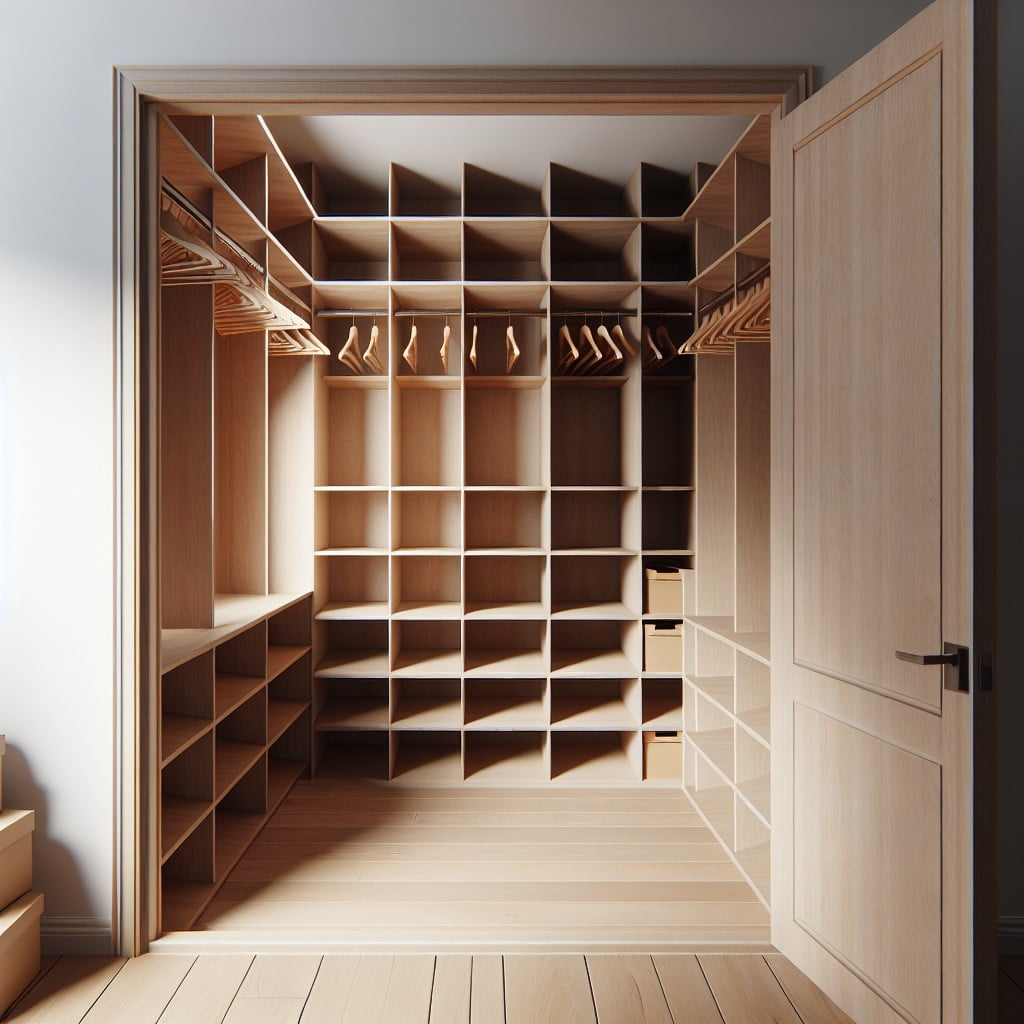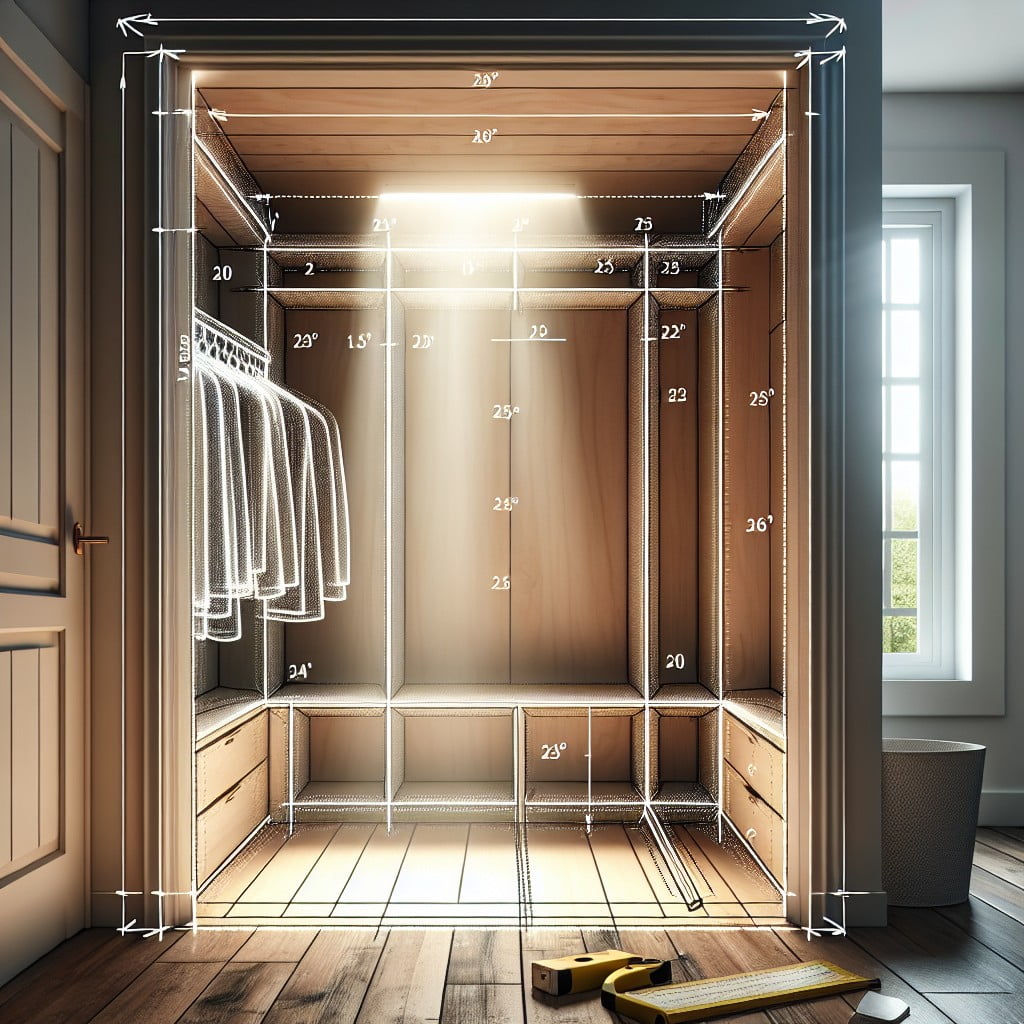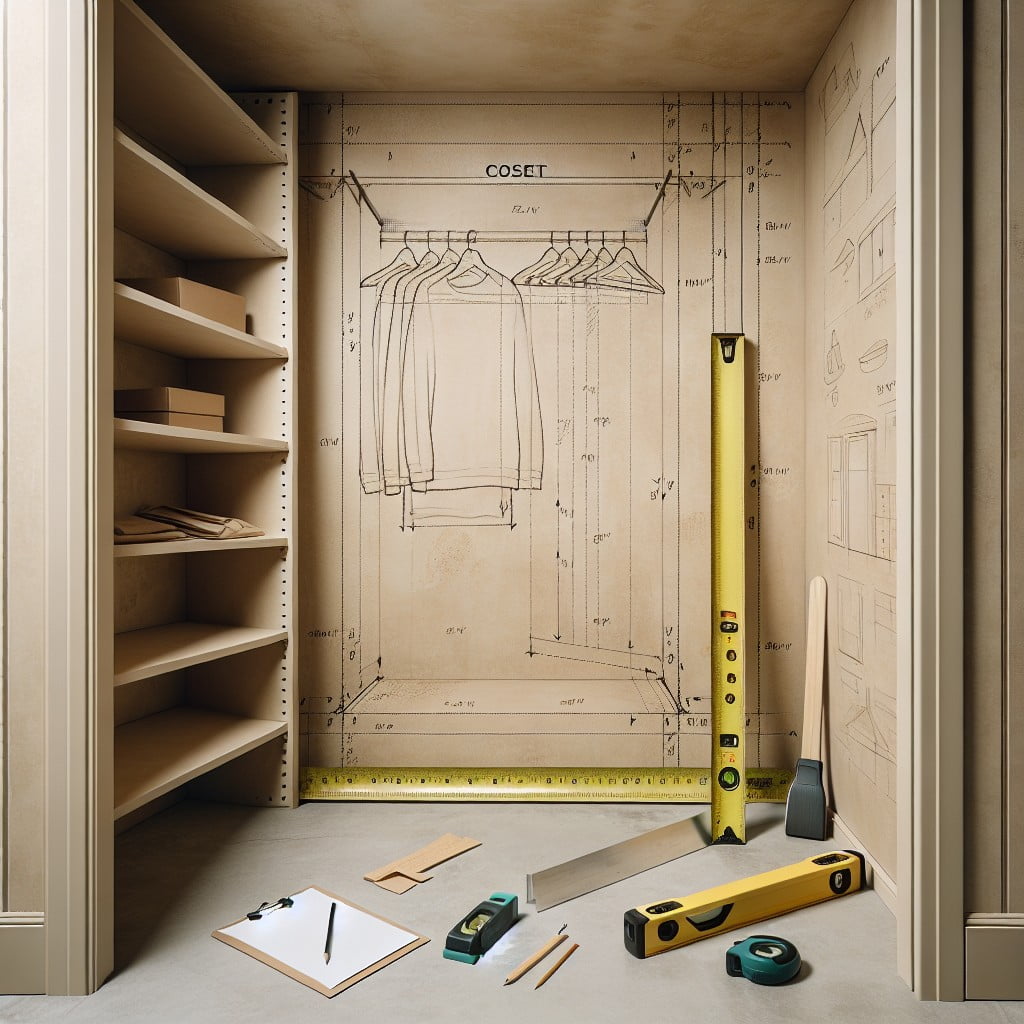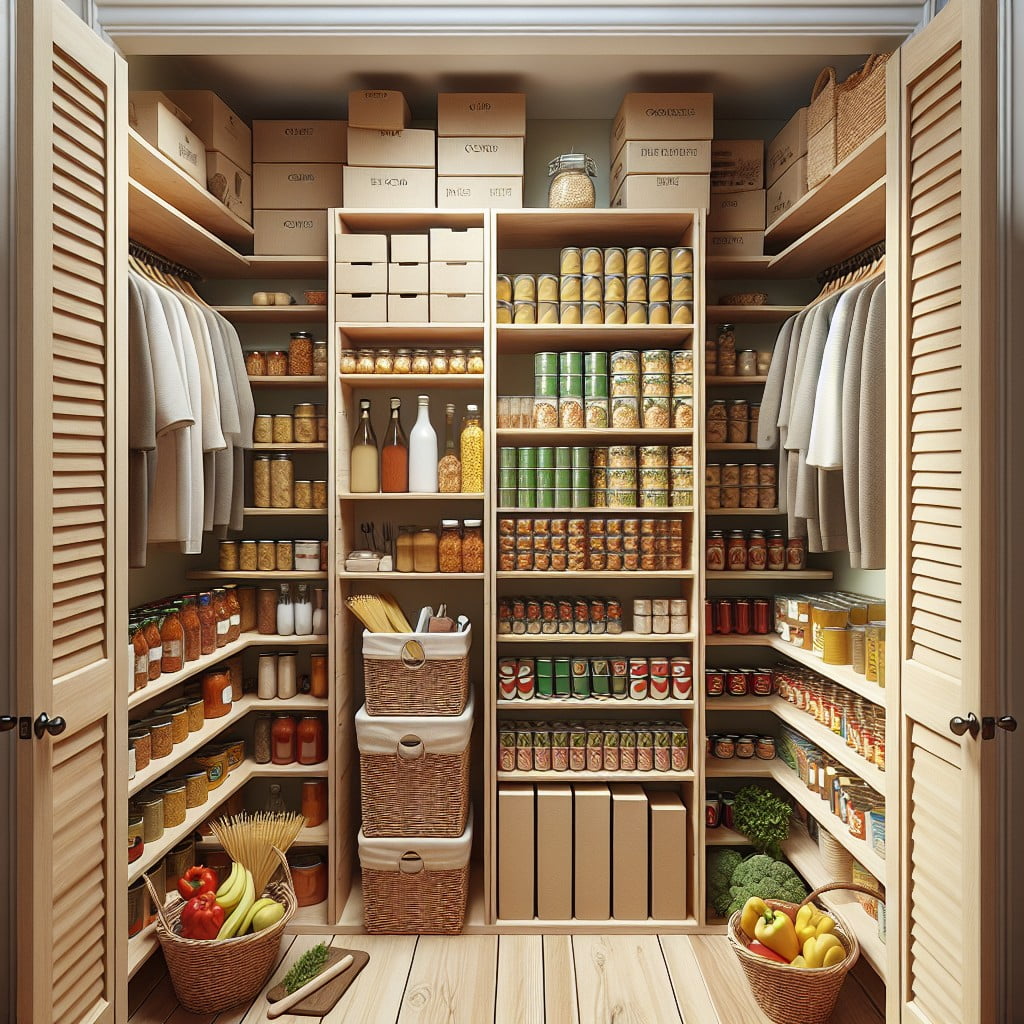Last updated on
Transforming your coat closet into a pantry enhances your kitchen’s storage capabilities because it leverages underutilized space for storing canned goods, spices, and small appliances.
Key takeaways:
- Transform coat closet into pantry for enhanced storage capabilities
- Assess dimensions, lighting, ventilation, door swing, and accessibility
- Measure for shelving, consider item size and weight for spacing
- Build shelves with appropriate depth, adjustability, and secure installation
- Choose sturdy materials, consider wood, melamine-coated particleboard, or wire shelving.
A Clean Slate

Before diving into the transformation, remove all items from your coat closet. This blank canvas approach allows you to envision the new space without distraction.
Inspect the walls, floor, and door for any needed repairs or updates, such as patching holes or a fresh coat of paint. This initial step lays a clean foundation for your pantry conversion, ensuring a solid and fresh start.
Assessing Your Space

Before transforming your coat closet into a pantry, take a thorough look at the space available. Here are some points to consider:
1. Dimensions: Measure the height, width, and depth of the closet. Accurate dimensions are crucial for selecting appropriately sized shelving and storage solutions.
2. Lighting: Evaluate the current lighting situation. Pantries require good visibility, so consider adding battery-operated lights if there’s no power source.
3. Ventilation: Pantries need proper airflow to keep food fresh. If ventilation is inadequate, explore options like a vented door or a small, battery-operated fan.
4. Door Swing: Check if the door opens outwards or inwards. An outward-opening door provides more interior space, while an inward-opening door might limit storage options.
5. Current State: Inspect for any damages such as cracks, peeling paint, or a sagging structure. Address these issues to ensure a clean and stable foundation for your pantry goods.
6. Accessibility: Make a quick note of how easy it is to access the closet. Is it in a convenient location for kitchen activities? Pantry items should be easily reachable when cooking or meal planning.
By thoughtfully assessing your space, you set the stage for a successful conversion, ensuring that your new pantry will be both practical and pleasing to use.
Measuring for Shelving

Before purchasing or building shelves, accurate measurements are pivotal to ensure a proper fit and maximum storage efficiency. Start by measuring the height, width, and depth of the closet space. Record these dimensions, keeping in mind any irregularities in shape or obstacles like pipes or molding.
Consider the size of the items you plan to store, as this will inform the spacing between shelves. For instance, if you intend to store tall cereal boxes or appliances, you will need to allocate more vertical space than if you are storing canned goods or spice jars.
Also, calculate the weight of the items to determine the sturdiness required for the shelving materials. Heavy items like canned goods and bottles will necessitate stronger, more robust shelving compared to lighter items.
Don’t forget to factor in any protruding hinges or door frames that could impede the shelving. It may be necessary to either adjust the shelf sizes or plan to mount the shelves away from these impediments to ensure a smooth installation.
Building the Shelves

When constructing shelves, determining the appropriate depth is crucial. Shelves that are too deep may cause items to get lost in the back, while shallow ones may not hold larger items effectively. Aim for a depth that accommodates most pantry goods, typically between 16 to 20 inches.
Favor adjustable shelving units for added flexibility. These allow you to modify shelf height as needed to accommodate items of varying sizes. Utilize the entire closet height, but ensure the top shelves are reachable with a sturdy step stool.
If you’re comfortable with DIY, building the shelves from scratch can be economical. Plywood is a popular choice for its cost-effectiveness and durability. However, pre-made shelves are available for a swifter transformation and can be found in various materials to suit different budgets and aesthetic preferences.
Ensure that the shelves are securely fastened to the walls, especially at the studs, for stability. If wall studs are not accessible, use heavy-duty wall anchors designed to support the weight of fully loaded pantry shelves.
Lastly, coat the wood with a non-toxic sealant to protect against moisture and make cleaning easier. This step will help maintain the shelves for years to come.
Choosing the Right Materials
Selecting the appropriate materials for your shelving is crucial, not only for aesthetics but also for durability and functionality. Opt for sturdy wood like pine or birch if you’re gunning for a traditional look and feel. These woods can be painted or stained to match your decor, plus they offer robust support for heavy items.
Consider melamine-coated particleboard for a budget-friendly yet clean and modern appearance. It’s resistant to stains and easy to clean, a practical choice for a pantry setting. Wire shelving is another viable option, especially if ventilation and visibility are your priority. It’s lightweight, easy to install, and you can see through to every item, ensuring nothing gets lost at the back of the pantry.
For those in seismic zones or with young children, securing shelves with metal brackets and rails adds an extra layer of safety. Not only do they fortify the structure, but they also present an industrial edge to the design, should that complement your home’s style.
Custom Shelving Options
When tailoring your shelving to suit your specific needs, consider a mix of fixed and adjustable options. Fixed shelves, secured permanently in place, offer stability for heavy items like canned goods. Adjustable shelves, on the other hand, provide flexibility to accommodate items of varying heights—from tall bottles of oil to small spice jars.
Sliding drawers can be a game-changer for lower sections, making it easy to reach items tucked away at the back.
For corner spaces, installing lazy Susans can maximize storage and convenience. For a personal touch, integrate wine racks or specialty storage designed for unique items such as baking sheets or cutting boards. Utilize vertical dividers for trays and platters to keep them neatly stacked and accessible.
Lastly, consider the depth of your shelves. Shallower shelves help prevent items from being lost at the back, while deeper shelves might be necessary for storing bulkier items. The key is finding the right balance to ensure every inch of your new pantry works hard for you.
Organizing the Pantry
Once the shelving is secure in your new pantry, creating a functional and easily navigable space is key.
Group similar items together to streamline your grocery retrieval process. Place frequently used items, like snacks and spices, at eye level while less-used bulk items can be stored higher up.
Employ stackable clear bins to maximize vertical space and keep an inventory visible. Consider a lazy Susan for corner shelves to access those hard-to-reach items. If you bake often, dedicate a shelf to baking ingredients and supplies for efficiency.
Integrate drawer inserts or small baskets for loose packets and smaller items that could easily get lost among larger goods. For safety, store heavier objects on lower shelves to avoid lifting them from over your head.
Use labels to mark shelves and containers. This not only helps you find items quickly but also guides other household members and maintains order. Stick to a first-in, first-out rotation system, placing newer items behind the old, ensuring nothing gets buried and expires. This organization method not only saves time but can also prevent waste and overbuying.
Best Practices for Shelf Arrangement
To optimize your pantry’s functionality, group items by category, such as baking ingredients, breakfast items, canned goods, and snacks.
This system streamlines meal preparation and helps you quickly take inventory before grocery shopping.
Place frequently used items at eye level for easy access, and reserve higher and lower shelves for less often needed goods.
Within each category, arrange products by height, with taller items at the back and shorter ones in front, ensuring nothing gets lost or forgotten.
Consider employing stepped shelf organizers to improve visibility for smaller cans and jars.
To prevent spills and messes, utilize trays or bins for sauces and oils.
Finally, enable smooth visual scanning by foregoing cluttered arrangements and leaving a bit of space between different items.
Use of Clear Storage Containers
Transparent containers offer an at-a-glance inventory, simplifying meal planning and shopping lists.
Stackability maximizes vertical space, and maintaining an organized look is easier.
For dry goods like flour and sugar, these containers provide airtight storage, keeping contents fresh.
Labels can be a helpful addition, noting expiration dates and cooking instructions.
Opt for modular designs to fit various shelf heights, and choose BPA-free plastics or glass for health-conscious storage.
Labeling for Efficiency
Easily spotting your ingredients saves time and hassle. Adopt a labeling system that works for you—handwritten tags or printed labels are both great options.
Consider including dates on perishables to track freshness. Use uniform labeling for a clean, organized look and group similar items together. Clear, readable labels not only make finding items straightforward but also streamline your restocking process.
For those with dietary restrictions, color-coded labels can quickly signal allergen-free foods. Remember, the goal is to make meal prep and shopping lists more efficient.
Maintaining Your Pantry
To help ensure your pantry remains as organized and functional as the day you first stocked it, consider these actionable tips for routine upkeep:
- Schedule regular checks: Set a specific day each month to go through your pantry and remove any expired items, clean any spills, and reorganize as necessary.
- First-in, first-out principle: When restocking groceries, place newer items behind the older ones. This system helps in using up items before they reach their expiration date and avoids waste.
- Inventory review: Keep a running list of your pantry’s contents. This helps not only in meal planning but also in avoiding over-purchasing items you already have.
- Adjust as needed: Be flexible with your organization system. If certain items aren’t being used frequently or are hard to reach, reposition the shelves or the items themselves to accommodate your daily needs.
- Clean surfaces: Wipe down shelves and containers regularly to keep the area clean and pests at bay. It also helps in keeping the space looking and feeling fresh.
By incorporating these habits into your routine, you can maintain a clean and efficient pantry that simplifies your food storage and preparation process.
Routine Upkeep Tips
Safeguarding the order and functionality of your pantry requires regular attention. To prevent clutter from overtaking your newly converted space, integrate these maintenance habits into your routine:
- Weekly Inventory: Take stock of what you have and what’s running low. This not only prevents overbuying but also helps you keep the shelves from becoming overcrowded.
- First In, First Out: When restocking items, always rotate older goods to the front. This practice is essential in minimizing waste and ensures that nothing gets lost or expires at the back of the shelf.
- Clean as You Go: Immediately address spills and crumbs. Allowing these to sit can attract pests and create sticky residues that are harder to clean later.
- Regular Decluttering: Each month, re-assess the necessity of the items. If something hasn’t been used within that period, consider if it belongs in the pantry or would be better suited elsewhere.
- Adjust as Needed: Be flexible with your layout. As your needs change, so can your pantry. Periodically evaluate if the current shelf configuration still suits your lifestyle.
Utilize these tips to keep your pantry efficient and effortlessly organized, transforming maintenance from a chore into a seamless part of your routine.
Restocking Essentials
Maintaining a well-stocked pantry is all about balance and awareness. Keep track of items you use frequently and consider adopting a two-bin system: one for use now and one as a backup. Invest in a whiteboard or a small chalkboard to jot down items as they run low, which will make your shopping list practically write itself.
It’s also wise to designate an area of your pantry for bulk purchases. Storing surplus cans or grains here ensures that you’re never caught off guard by an empty container. Finally, embrace the first-in, first-out rule; rotate your stock, placing newer items at the back to ensure nothing expires unseen at the far reaches of your shelves.
By regularly monitoring and restocking the essentials, your transition from coat closet to pantry will support a seamless kitchen experience, keeping meal preparation and snack times running like clockwork.
Additional Storage for the Walls
Maximize every inch of your transformed coat closet by employing wall space for extra storage. Install hooks or pegboards on the inside of the door or available wall areas to hang aprons, measuring cups, or reusable grocery bags.
Consider a wall-mounted spice rack to keep seasonings within reach while freeing up shelf space. Magnetic strips are also an efficient way to store knives and metal utensils, keeping them organized and easily accessible.
If the height allows, a high shelf can be added to stash seldom-used items like special occasion serveware or bulk paper goods, ensuring they don’t clutter your everyday working space.
For a touch of personalization and increased functionality, add a small chalkboard or whiteboard to keep track of groceries or meal planning.
Under-Shelf Storage
Exploiting the vertical space beneath your shelves opens up a new avenue for optimal organization. Consider investing in under-shelf baskets to slide onto the existing shelf; these are superb for tucking away less frequently used items or housing bags of snacks and bread.
Hooks can also be affixed directly underneath to hang aprons, oven mitts, or even a banana bunch.
Let’s not overlook the possibility of installing a pull-out drawer system that fits snugly, providing an accessible home for small jars and spices.
The key here is to maximize every inch of available space while keeping the contents visible and reachable, ensuring a fully functional pantry that caters to your everyday needs.
FAQ
How much does it cost to convert closet to pantry?
The average cost to convert a closet into a pantry ranges from $300 to $2,000, factoring in the cost of materials like shelving and storage containers and labor if you opt for professional installation.
Can a pantry be a closet?
Yes, a pantry can indeed be a closet as it is often designed to store substantial quantities of items including food, water, and household supplies like paper towels.
How do I turn my room into a pantry?
To convert your room into a pantry, construct customized shelves in a bi-fold or sliding door closet that can be installed directly and filled with items, or develop an internal organizer all according to your preference.
What are the essential items needed in transforming a closet into a pantry?
To transform a closet into a pantry, you will need adjustable shelving, storage bins and baskets, can organizers, jar labels, and drawer liners.
Are there any specific regulations or guidelines to follow when converting a closet into a pantry?
There are no specific universal regulations for converting a closet into a pantry, but individual city or regional building codes may apply, so it’s advisable to check local regulations before starting the project.
What are the benefits and potential challenges of converting a coat closet into a pantry?
The benefits of converting a coat closet into a pantry include maximizing use of space, accessible organization, and custom storage solutions, while challenges may include limited closet size, lack of proper ventilation, and potential costs associated with renovation.
Recap:




